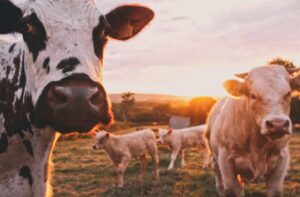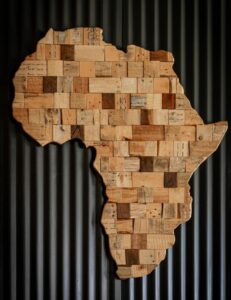The farming sector is arguably the most important economic sector for South Africa’s development as it is directly linked to food security and poverty reduction. In 2019, 5.3% of employees in South Africa were in the agricultural sector and in 2020, agriculture contributed around 2.5% to the country’s GDP. The constitutional right to food puts food systems and agricultural development firmly on the national development agenda.
South Africa’s history shaped farming into a two-part system: large-scale commercial farmers and small-scale farmers. Both types are important in the agricultural economy.
Large-scale commercial farmers are typically viewed as the main drivers of national food security, producing about 80% of the country’s food. The small-scale farmers have been promoted by government as significant drivers of household food security. In 2017 almost 20% of South African households had insufficient food.
The existence of these two systems remains a sign of injustice and inequity. South Africa’s efforts to reform land distribution have tended to focus on this duality.
There’s a problem with this approach: land isn’t the only determinant of success in farming. The other three main drivers of production in agriculture are labour, capital and enterprise. If land was the only factor that counted, there’d be no need to consider market access or trade between the formal and informal sectors.
Farming isn’t isolated from the broader economy. There’s a need for a more holistic approach to farming systems in South Africa – a systems approach.
This was the way we approached a study of a farming area in South Africa. The study took place in the Vhembe district of the Limpopo province, where both commercial and small-scale farming occurs.
We looked at factors like farm size, land ownership, topography, soil description, rainfall and threats like theft and disease, to see how these related to yield and income from three crops. The macadamia nuts, mangoes and avocado pears grown in the area are all high value commodities. We also considered how production under the two types of farming could sustain long-term food security at national and household level.
Among our findings was that yield depended on an array of land management aspects, not just on farm size. Sustainability didn’t depend on security of land tenure.
Findings like this can help target investments more fruitfully and feed into the ongoing land reform debate. Since both types of farming are important, any efforts to address the country’s long term food security should consider the complex connections between them and how this connectedness brings about food production.
The research
Agriculture is the key contributor to employment and livelihoods in the Vhembe district where we did the research in late 2020. The area is semi-arid and frequently affected by dry spells. Most commercial farmers rely on irrigation systems while the small-scale farmers depend on seasonal rainfall.
We interviewed 19 local farmers in depth – men and women. A majority (70%) of the participants were small-scale farmers with communal land tenure; 30% were involved in large-scale commercial farming. We also collected official data on climate, land type and soils, and consulted academic sources.
The analysis aimed to highlight the connectivity of interactions between the farming systems in terms of the four drivers of production: land, labour, capital and enterprise.
Most farmers in the district (79%) were men and 90% were above the age of 51. Communal land ownership was the dominant (74%) form of land ownership among participants.
Access to water for irrigation was a big constraint for small-scale farmers.
We found that crop theft was the biggest threat, particularly on small farms, mainly due to inadequate fencing.
Crop yield wasn’t solely dependent on farm size. For macadamia farmers, the link between farm size and yield was positive but weak. For mango and avocado farmers, bigger farms yielded less than smaller ones.
For income, however, there was a strong correlation with farm size.
The study showed that changes in land management and access to additional income from off-farm activities can support the sustainability of farms.
It has been argued elsewhere that secure land tenure is a necessary pre-condition for sustainable farming practices. Our study results don’t support this theory. The majority of our respondents farmed on communal land yet they were sustainable (through incorporating off-farm activities).
Changes to land tenure policy in the Vhembe district could have a negative impact on the sustainability of both farming systems – commercial and small-scale – if it didn’t consider overlapping land use rights for people living on communal land, among other things. For example, even if a small-scale farmer were to be given ownership of a portion of communal land, they might plant crops on the land only to have someone else’s cattle graze there after harvest.
In relation to the capital and enterprise drivers of farming, we found that the two systems don’t respond in the same way. A large-scale commercial avocado farmer, for example, will be able to transport produce quickly from farm to pack house, where it’s prepared for market. A small-scale avocado farmer from the same location may not have transport and will have to sell the produce at local markets.
Our study shows that there are significant points of connectivity between the two types of farmers. These include the supply of plants and produce between the two types of farms and the exchange of farming information. This shows that there’s potential for the two types to work together to achieve food security.
A systems approach
Our study highlights the need to shift from a mindset of hierarchies to networks when solving the challenges of farming systems in South Africa. Existing policy frameworks are generally designed with a linear approach. Suggested solutions to specific problems don’t consider the many instances where there’s connectivity between the two farming systems. Neglecting this fact makes solutions less effective.
Decision making also depends on collecting essential data against the backdrop of constantly changing environmental, political and socio-economic conditions.![]()
Fenji Materechera, PhD Candidate in Systems Analysis, University of the Witwatersrand and Mary Scholes, Professor and holder of a Research Chair in Applied Systems Analysis, University of the Witwatersrand
Photo by Steven Weeks on Unsplash
This article is republished from The Conversation under a Creative Commons license. Read the original article.



